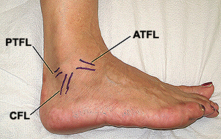Ankle Sprains
By Ed Murray, Podiatrist in Sydney
Almost anyone that has been involved in any sport over any period of time has at some stage rolled their ankle. And unfortunately ankle injuries lead to more ankle injuries, particularly with no rehab. It is commonplace for people to describe a history of rolled ankles before THE rolled ankle that did the real damage. So if you’re one of those “I always roll my ankle” types or are interested in improving your ankle range, strength and stability, listen up.
Anatomically speaking, the major site of ankle trauma is the Anterior Talo-Fibula Ligament (ATFL). Other ligaments are sometimes involved, particularly in more serious injuries, but the ATFL is that major site of trauma, pain and dysfunction so lets focus on that for now.
Ankle Anatomy
Quick anatomy lesson. Study the Anterior Talofibular Ligament (ATFL). It attaches the Fibula (outside leg bone) to the Talus (top of foot/ankle) bone. That funny little hole in the front, outside part of your ankle...the ATFL is around there.
Now consider if the ATFL wasn’t there or it was damaged. The Talus (foot bone) would weaken its attachment to the fibula (leg bone). So the foot could drift forward, away from the leg. And in small but clinically relevant amounts, that does indeed occur.
What does this mean?
The ankle joint becomes less stable.
The body will try to protect the joint in a series of ways. 1) Pain, to limit further damage. 2) Muscles tighten/stiffen to limit movement. 3) Swelling, to stimulate the healing process.
Reduced proprioception: “The ankle just doesn’t feel as strong as it use to” is what people say. That’s poor proprioception. And that’s why certain people seem to sprain their ankle repeatedly, in seemingly innocuous incidents.
Structural change: As the talus drifts forward, it also tilts downward and inward. This causes a relative ‘flattening’ of the arch which can lead to other foot issues.
How to treat Ankle Sprains (in this order):
Reduce excessive inflammation (immediately): Rest, Compress, Anti-inflammatories (if you’re comfortable taking them)
Restore Range
Hands on therapy. Mobilisation techniques. Soft tissue therapy to release tight, stressed fascia and muscles. Having a trained professional who specialises in targeting the correct joints and muscles in the correct way is paramount to making a fully and speedy recovery.
Lower limb stretching - pain free
Stability
Retraining proprioception at the foot and leg is really important. Optimise the communication between the brain and the foot.
Strength
Calf strength is a great indicator of ankle happiness.
Walking, running and jumping are all very much single footed activities. Push off one, land on the other. So single limb function is vital to rehabilitation.
Single limb balance and strength exercises
If you are someone struggling with either acute or chronic ankle problems - we are here to help. It’s super easy to book an appointment, just click the link below to find yourself a time that suits you.


